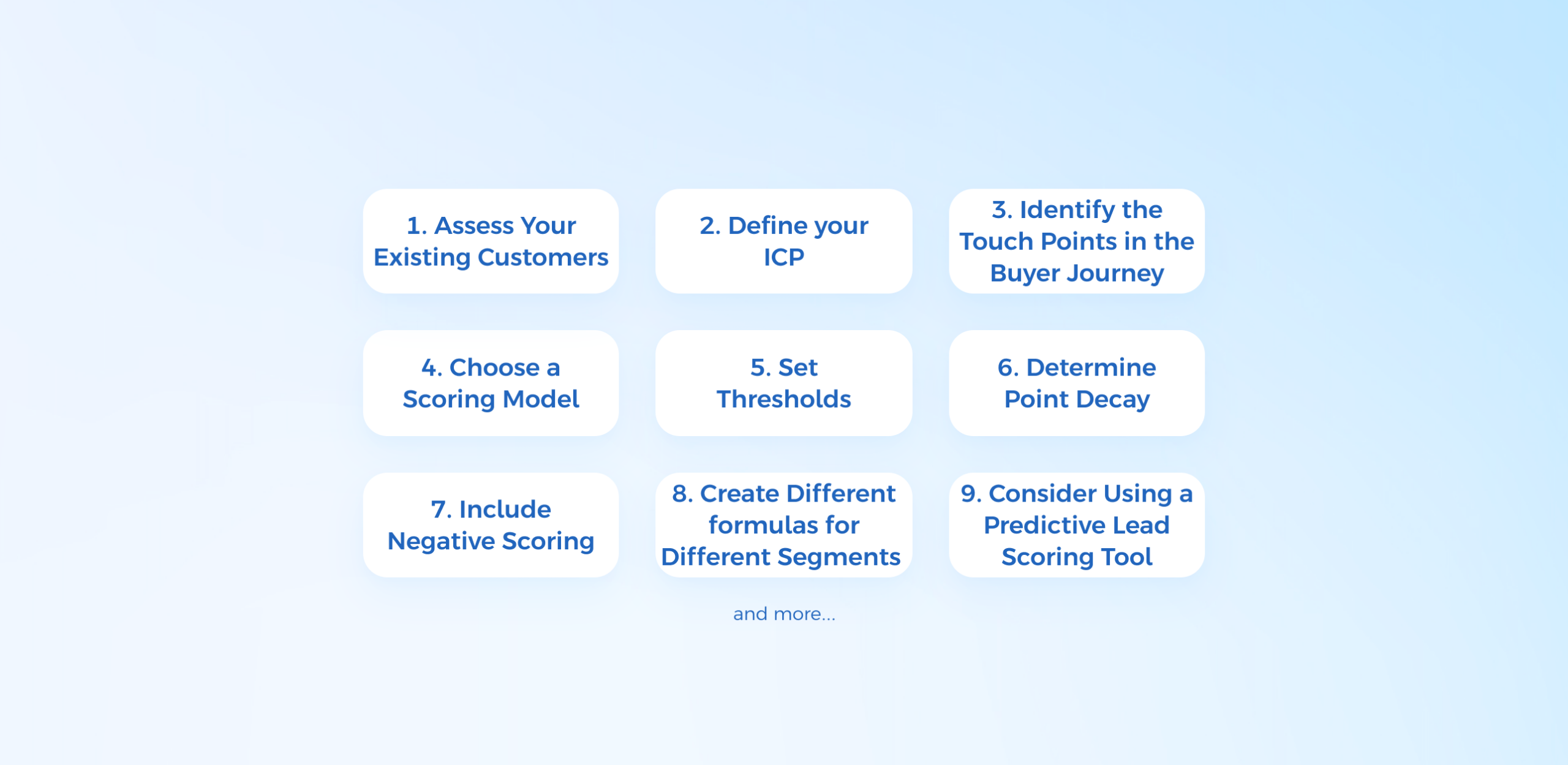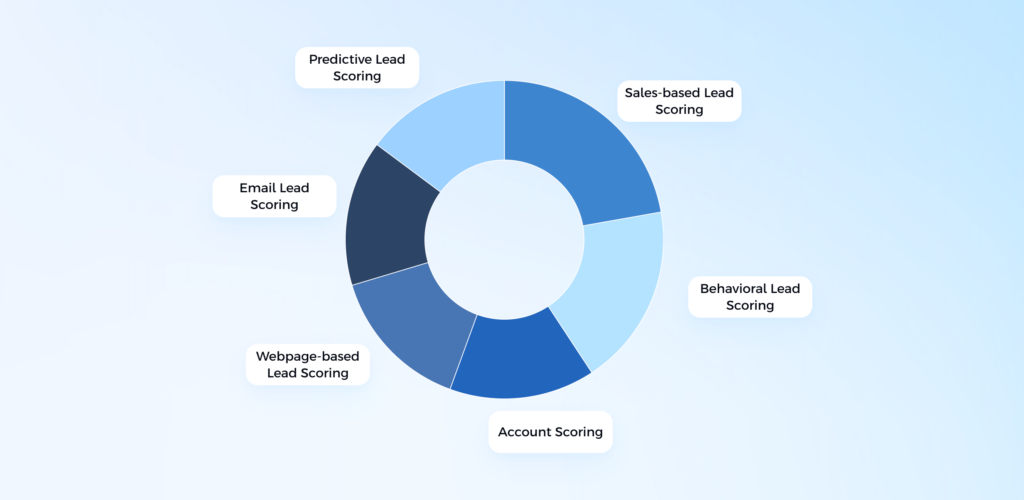Every strategy or method has its best practices designed to make our work both effective and efficient. By following these proven guidelines, we simplify our tasks and improve our overall performance.
This is especially true in the context of lead scoring, an essential aspect of sales and marketing efforts. I’ll share the lead scoring best practices I’ve experienced so far and offer tips, to improve your strategies and performance, too.
If you want to start from scratch in lead scoring, I won’t take your time explaining what is lead scoring or what are lead examples here. You can read these resources in order first, and come back:
- What is lead scoring?
- Why you should use lead scoring?
- Lead scoring examples
- Lead scoring criteria
- Lead scoring template
- Lead scoring tools
- HubSpot lead scoring (if you are using HubSpot)
- Here you are!
Lead Scoring Best Practices
I want to categorize the best practices I want to share with you in three parts: general best practices, best practices for HubSpot lead scoring, and best practices for UserMotion predictive lead scoring. So, you can go for the one you desire, but do not skip the general ones.
General Lead Scoring Best Practices
1. Assess Your Existing Customers
The first practice I want to share is analyzing your current customer base to understand the traits of your high-value customers. This will help you identify what to look for in potential leads.
If you notice that most of your high-value customers come from the technology sector and often engage with specific content on your website, you can assign higher scores to leads fitting this profile.
2. Define your ICP
I say it everywhere in our resources, articles and even on social media: ideal customer profiling is the best thing you can do for lead scoring. It is the base of all these qualification points.
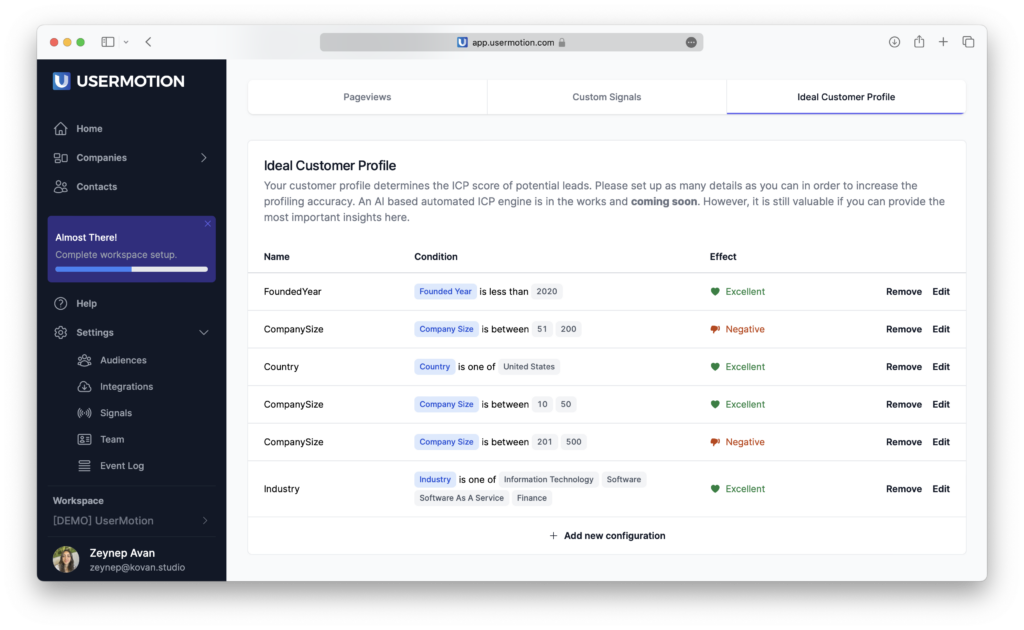
You need to clearly outline the traits and characteristics of your ideal customer. This profile should guide which leads are prioritized.
An ICP for a B2B software company might include industry, company size, job title, and specific pain points that the product addresses.
3. Identify the Touch Points in the Buyer Journey
To go further in lead scoring, you need to go beyond demographics and firmograhics traits and signals. Map out the buyer’s journey to understand key interactions leads have with your brand. You can use Miro to visualize each stage and have a clear view.
This helps to assign points based on their actions. Points can be assigned for visiting pricing pages, contacting support, completing onboarding or connecting integrations. All these actions show that they are moving towards the funnel and purchase intent.
4. Choose a Scoring Model
Decide on a model that best suits your sales funnel and customer journey. This may include lead scoring models such us sales-based scoring, behavioral scoring, predictive scoring, email scoring, etc.
For a subscription-based PLG products, for example, behavioral and predictive scoring models might be the best to identify opportunities based on usage patterns.
5. Set Thresholds
Define score thresholds that categorize leads into different qualification levels, such as Marketing Qualified Lead (MQL), Product Qualified Lead (PQL) or Sales Qualified Lead (SQL).
A score between 50-60 categorizes a lead as an MQL, while a score above 60 marks it as a SQL and a score above 80 as a PQL ready for sales interaction.

Or you can also define thresholds to categorize leads into different levels of sales readiness. By categorizing leads into ‘hot’, ‘warm’, and ‘cold’ based on their scores, businesses can prioritize follow-ups more effectively.
- 70+ Hot High priority for follow-up. Leads most likely to convert.
- 40-69 Warm Moderate priority. Leads showing interest but may need more nurturing.
- Below 40 Cold Low priority. Leads least likely to convert in the short term.
6. Determine Point Decay
Implement a system where points decrease over time if a lead does not engage with your brand, ensuring your scoring reflects current interest levels.
Deduct points for each month of inactivity to prevent old leads from being over-prioritized.
7. Include Negative Scoring
Not all actions should increase a lead’s score. Implement negative scoring for indicators of low engagement or actions that show a lead is less likely to convert. This ensures your focus remains on high-quality prospects.
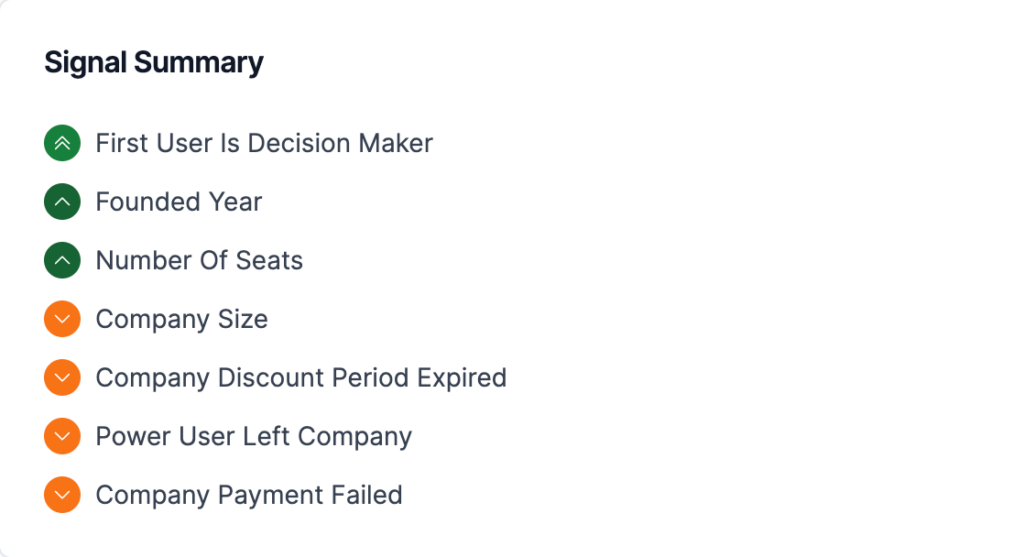
Assign negative (-) scores for prospects who consistently only engage with low-purpose content or for whom the decision maker deletes the account.
In fact, here’s a list to inspire you on how you can create negative signals:
- Workspace deleted (-15)
- Company payment failed (-15)
- Visit on cancel page (-10)
- Company discount period ended (-10)
- Decision-maker left the company (-10)
- Integration uninstall (-10)
- Key event not performed in the last 30 days (-10)
- No activity for 30 days (-10)
- Email unsubscribe or spam complaint (-5)
- Social media negative engagement (-5)
8. Create Different formulas for Different Segments
You might be targeting different audiences or segments for different use cases. Or, the wight of scores for different plan and pricing of your product can vary. In this scenario, customize scoring formulas based on different lead segments to reflect varied buyer behaviors and preferences.
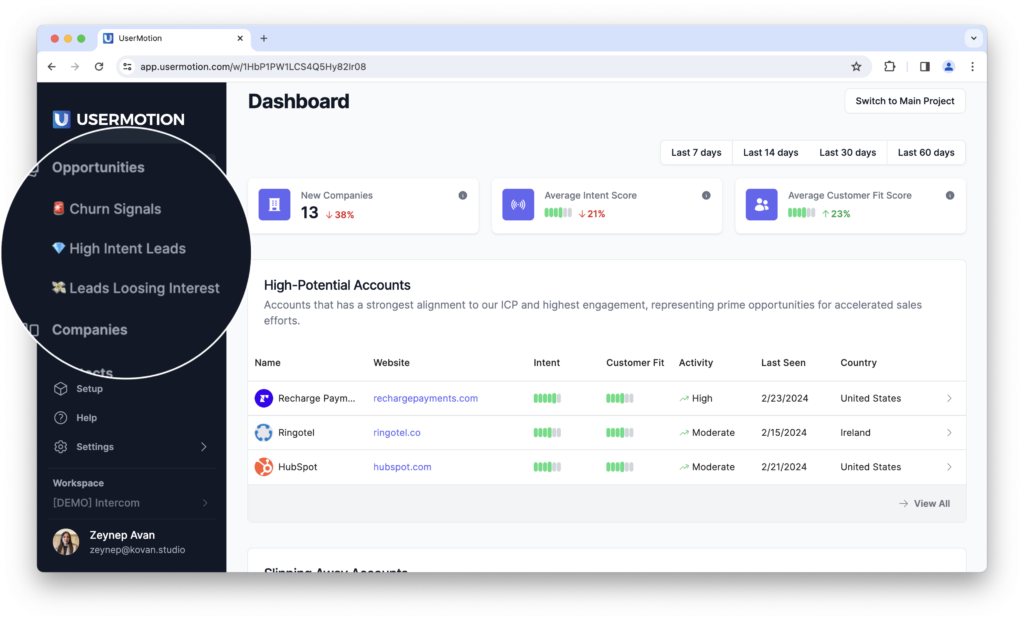
Leads interested in a premium product might receive more points for certain actions compared to those interested in a basic offering.
9. Consider Using a Predictive Lead Scoring Tool
Predictive models are perfect for analyzing historical data and exiting behaviors into lead to customer conversion. So, you can also consider using such tool to automate and refine the lead scoring process based on comprehensive data analysis.
These tool can accurately assess leads based on both their demographic data and behavior, taking into account the recency and frequency of actions.
Tools like HubSpot, UserMotion or Madkudu can dynamically score leads based on a mix of demographic information and engagement metrics.
10. Align Sales and Marketing
Ensure both sales and marketing teams agree on what qualifies a lead at each stage of the funnel for a seamless handover process.
Jointly define what behaviors and characteristics qualify a lead as an MQL, SQL or PQL, ensuring sales readiness.
11. Regularly Update and Refine Your Strategy
Continuously evaluate and adjust your lead scoring strategy to accommodate changes in customer behavior, market trends, and the effectiveness of your scoring model.
The adjustments may include including new attributes or adjusting weights in response to changes, such as increased conversions from certain channels like LinkedIn or shifting preferences for digital content like webinars. This continuous improvement ensures that your lead scoring remains effective in prioritizing leads.
HubSpot Lead Scoring Best Practices
1. Joint Effort and Evolution
Lead scoring should be a collaborative effort among marketing and sales teams and must evolve over time. As you add more assets and criteria, continuously refine your lead scoring model to reflect these changes effectively.
2. Manage Criteria Limits
HubSpot limits you to 100 total positive and negative scoring criteria. Look for opportunities to consolidate criteria to stay within this limit.
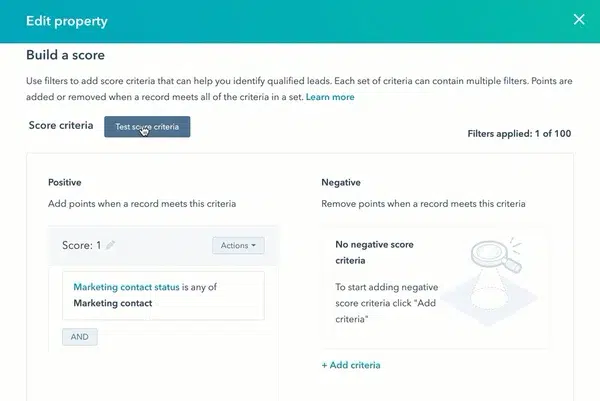
For example, use a form naming convention like “[eBook]” to score based on the inclusion of that tag within a form’s name, instead of scoring each form individually.
3. Set Appropriate Response Actions
Beyond simply notifying your team when someone hits the target lead score, set up automated email workflows triggered by specific lead scores.
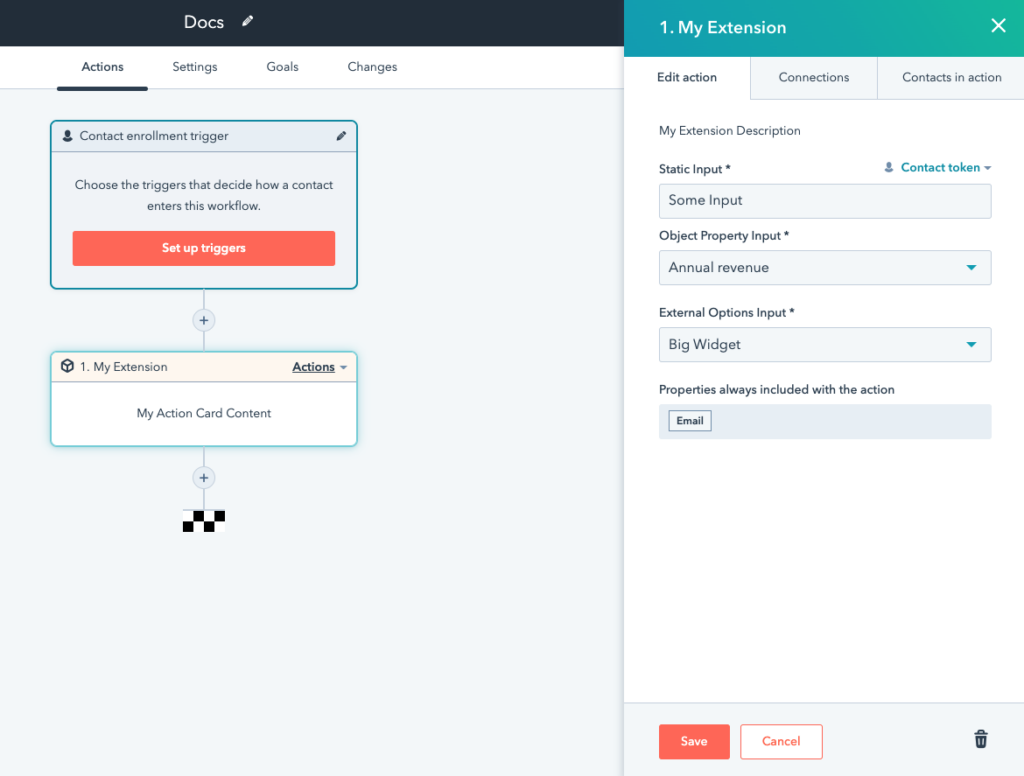
This allows you to engage leads at various stages of engagement effectively.
4. Exclude Non-Leads
HubSpot assigns scores to all contacts, so it’s crucial to factor out non-leads. Deduct significant points for contacts identified as non-leads (such as distributors, vendors, employees), as well as for those who have bounced, unsubscribed, or been marked as unqualified.
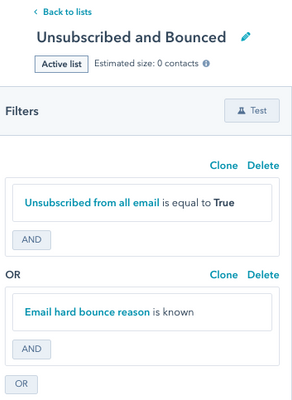
This ensures that your sales team only receives notifications for genuine, potential leads and not for non-leads or current customers.
UserMotion Lead Scoring Best Practices
1. Create Custom Audiences
We all want to go further in lead scoring and segmentation. So, UserMotion’s audience segmentation feature segment your leads or customer accounts based on specific properties, traits, and signals.
This enables the tracking of users as they transition between different audience categories, allowing for custom actions and communications.
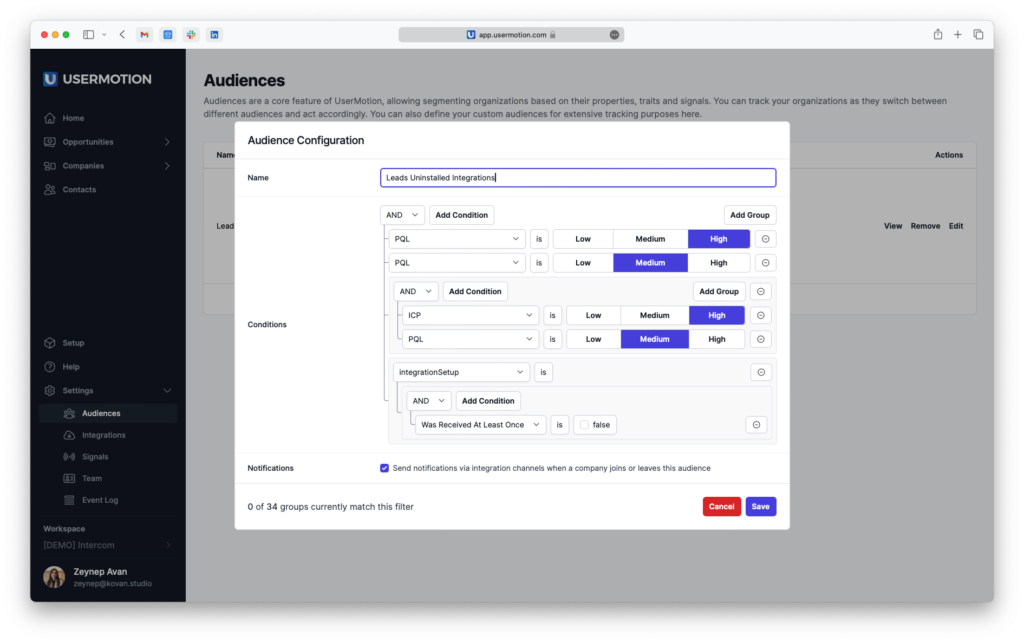
Let’s say you have an audience named “Leads Uninstalled Integrations.” with negative scoring as we mentioned above. You would segment this audience based on specific conditions, such as:
- PQL (Product Qualified Lead) score is either High or Medium.
- ICP (Ideal Customer Profile) score is either High or Medium.
- No recent setup of integrations (integrationSetup is False).
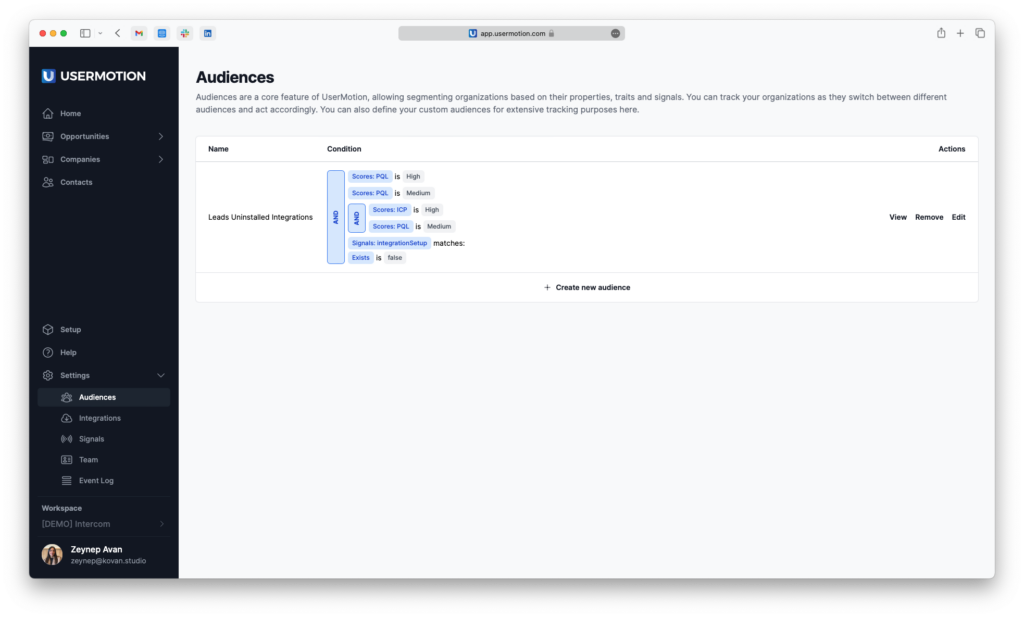
This audience can be of great importance for identifying potential customers who have disconnected, which allows you to target them with re-engagement campaigns or perform follow-up actions to understand the reasons for their removal.
2. Connect Your Payment Provider
Understanding conversion is vital: at what point do leads become paying customers, how long they maintain their subscriptions, and their overall contribution to revenue.
By integrating your payment provider like Stripe with UserMotion, you gain accurate visibility into these critical metrics.
This connection allows you to assign negative signals to behaviors such as the end of discount periods or declined credit cards, which can indicate the risk of customer churn or declining customer engagement.
The Stripe integration augments UserMotion’s capabilities, enabling you to:
- Analyze factors that contribute to your revenue streams and customer lifetime value.
- Sharpen your Ideal Customer Profile (ICP) by observing payment patterns alongside product usage.
- Quickly spot and act upon signs that might lead to customer turnover.
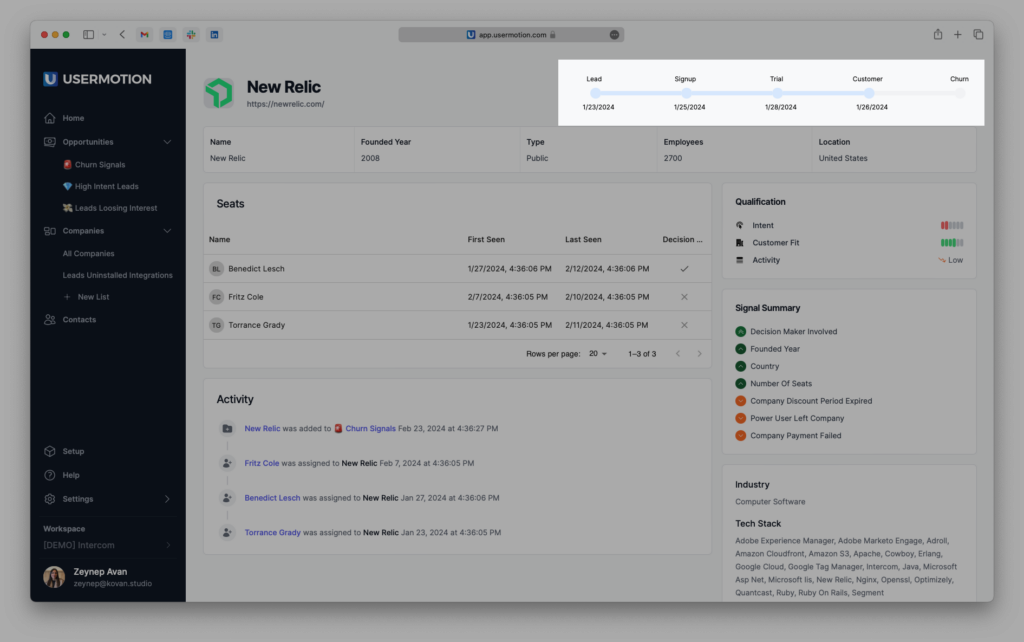
Stripe integration in UserMotion enables visualization of the customer journey through a timeline highlighting key milestones such as:
- Lead: The date a potential customer is first identified as a lead.
- Signup: When the lead signs up, indicating an initial level of engagement.
- Trial Period: The phase where the lead evaluates the product or service.
- Conversion to Customer: The point at which the lead becomes a paying customer.
- Ongoing Engagement: Regular interactions the customer has with the product, such as logins, feature usage, and communication with support or sales teams.
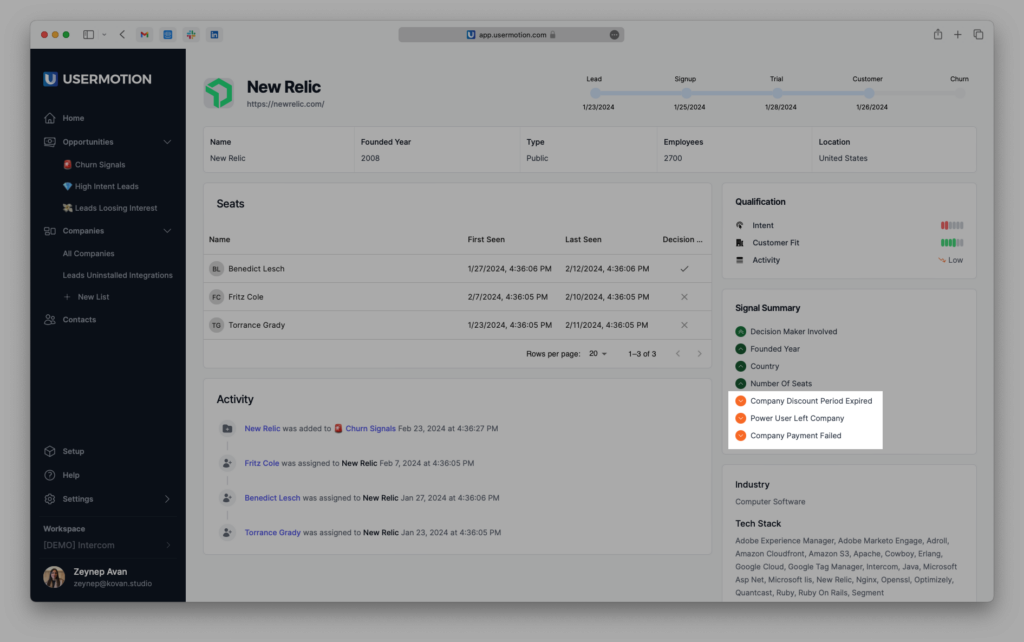
Other than that, by connecting your payment provider, you can also view churn signals in UserMotion, such as:
- Activity drop-off:
- Trial-to-payment transition
- Discount period ended
- Payment issues
- Changes in seat usage
- Disengagement with communications
3. Define Activation Events
UserMotion allows you to track and score even the smallest signal or indicator. In UserMotion, you can define as many key activation events as you like that indicate a lead’s deeper engagement or readiness to buy.
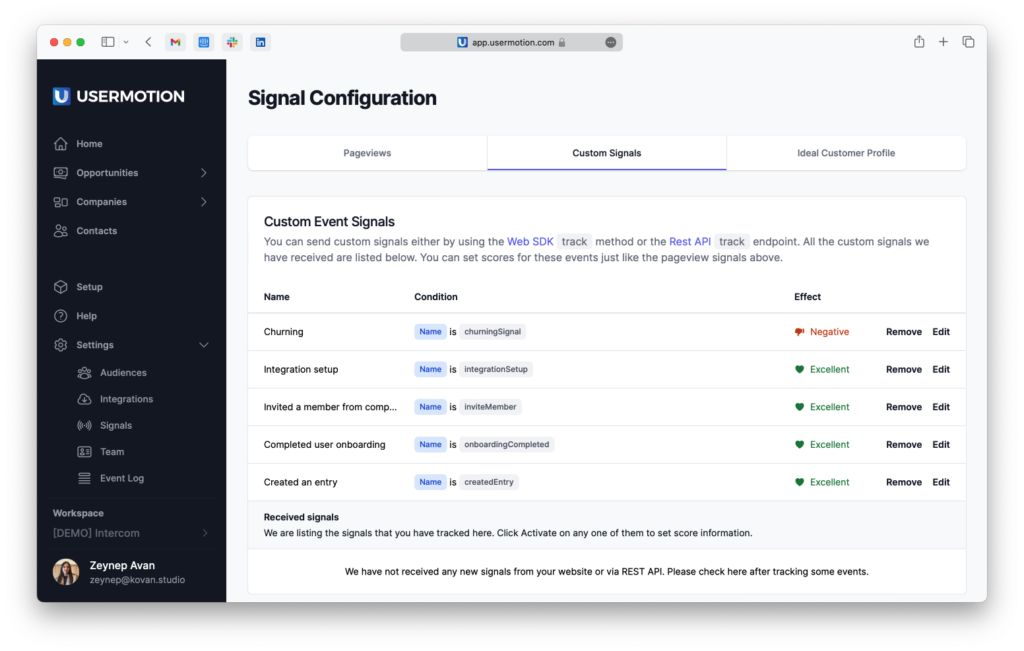
This could include the completion of a onboarding sequence, reaching a certain usage milestone, or using a critical feature. Track these activation events to score and prioritize leads more effectively.
4. Check Event Log If You Think There is an Interruption
To make sure that your data and scoring in UserMotion works properly, you can regularly check your event log to see if there was an interruption, misconnection or bug. You can contact customer support via Intercom chatbot to solve those kinds of problems immediately.
5. Connect Slack for Real-Time Notifications
Integrate UserMotion with Slack to receive instant alerts on lead scoring events. This can empower your team to act quickly on high-scoring leads or address concerns that may lead to a decrease in lead score, such as inactivity or negative feedback.
You can receive instant notifications about key interactions, ensuring you’re always in the know. Whether it’s new signups, visits to the pricing page, or moments when a decision-maker actively engages with your platform, you have all the information you need.
6. Connect Outreach to Trigger Sales Sequences
Integrate UserMotion with Outreach to pass lead scoring to sales success. With UserMotion’s scoring based on buyer intent and Ideal Customer Profile (ICP), this integration ensures your sales pipelines are focused on the leads most ready to engage and convert.
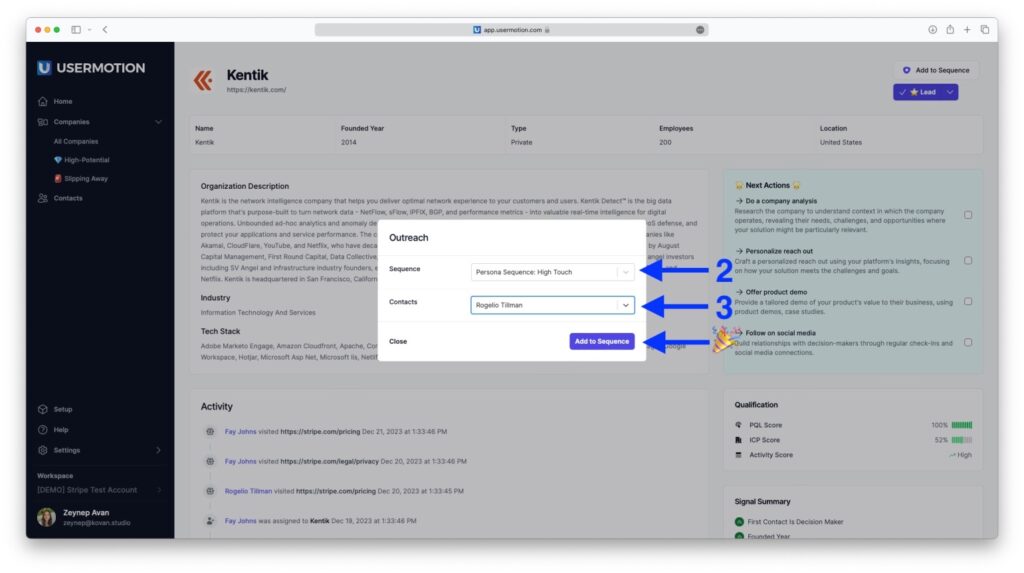
In UserMotion, identify a lead that aligns with your sales criteria and click the “Add to Sequence” button on their profile. This button is placed in the upper-right section for easy access. After that, Choose the Outreach sequence and contact to add that lead to your campaign.
7. Evaluate Your Average Scores for Improvements
Continuously analyze average intent scores and customer fit scores within UserMotion over different date ranges to measure the effectiveness of your lead scoring system. Use insights from new company data to refine your criteria, signals or weights.
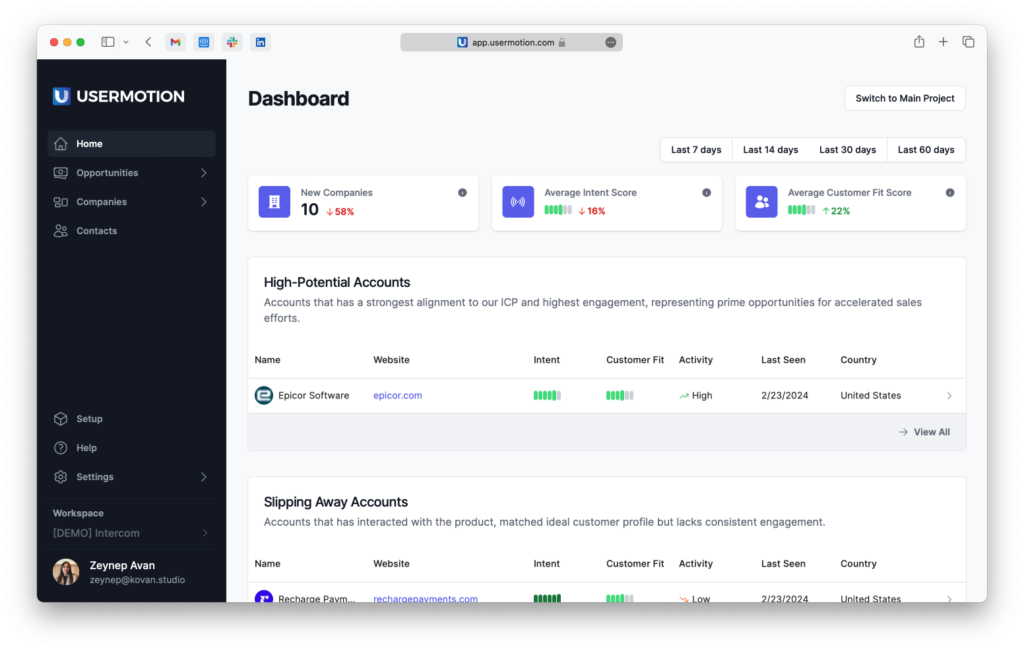
This analysis helps you identify areas for improvement, allowing for more refined targeting and improving your overall strategy for capturing high-potential accounts and addressing those who are slipping away.
Insights into Lead Scoring Best Practices
I think lead scoring is a key tool in marketing and sales, but it’s tricky to get right. Here’s the essence of what I’ve learned:
- Lead scoring is awesome but not straightforward. You need to learn a few tricks to make it work well for you.
- Different tools, different rules. What works for one system might not work for another. So, it’s important to customize your approach based on the tool you’re using, like HubSpot or UserMotion.
- UserMotion is super user-friendly. It’s easy to use and refine to get the best results. From setting custom alerts to integrating with payment systems like Stripe, it makes lead scoring simpler and more effective.
In short, lead scoring is about finding what works best for your specific needs. Keep refining and learning, and you’ll see better engagement and conversion from your leads.

